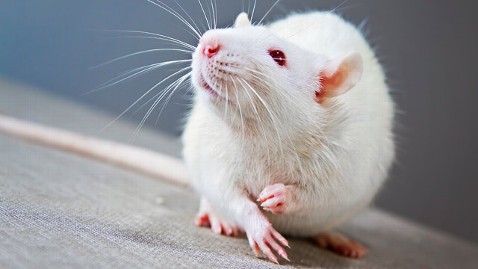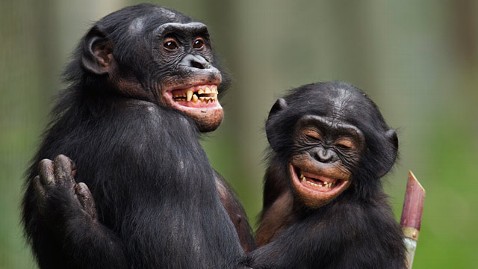About Your Face, Animal Person

(Getty Images)
We have the most expressive face on the planet … but then why did human males evolve big bushy beards?
Nature's Edge Notebook #22
Observation, Analysis, Reflection, New Questions
What is it exactly that makes us humans different from all the other animals?
Consider the human face.
One thing remarked on by many scientists we've talked to for this series on animal intelligence and play behavior is this:
Humans have evolved by far the most expressive face on the planet.
In fact, it may be one reason many scientists have been reticent until recently to recognize the probable certainty of deep-felt and complex emotions - even conscious emotions - in other species.
They can't see them.
Other species don't use their faces to convey a great complexity of emotions and thoughts to each other the way we do.
They can't.
No other species has evolved the intricate web of facial nerves (all connected to the thinking and feeling pathways in the brain) that we have, nor the subtlety of some 52 separate facial muscles whose emergence over the eons has accompanied the human rise to our current dominance over many aspects of life on this planet.
This is not to say other animals don't have complicated emotions and thoughts.
They just don't use their faces so much.
Take this rat:

(Eric Lorentzen-Newberg/Flickr Open/Getty Images)
Its face? All fur.
The evolutionary history for rat survival selected for other traits - many of which humans lack - including specialized scent receptors and eyes that see differently than ours do in dimly lit tunnels.
In fact, a specialization of the rat's facial fur - those whiskers - proved critical to rat survival.
Like super-sensitive antennae, their whiskers confer far greater advantage in tight spaces with little light than would the ability to show, say, a quizzical pout.
But touch (even tickling) and sound (including giggling laughter) could still serve rats in conveying helpful information, in bonding, and even in producing that great boon to the primal drive to live, fun.
Eventually one human scientist saw past the fur.
In one of the more delightful inter-species leaps in the annals of science, Jaak Panksepp had an idea one morning that brought him into his lab suggesting to a colleague, "Let's go tickle some rats."

(Henry Moore)
Note the rat's little front paw seeming to grip Panksepp's hand - not exactly pushing it away.
Using special microphones that can pick up high frequencies, he discovered the rats emit high-pitched giggling chirps when tickled, and even follow his hand around the cage begging for more. (As you can see in the video embedded in "8-Lessons learned by Tickling Rats…" listed below.)
Panksepp's work - and apparently the sheer power of laughter, even a rat's, to loosen up some set scientific minds - has helped open an enormous new field of "Affective Neuroscience" that traces the pathways of feelings and moods, conscious and unconscious, in brains, nerves and behavior in many species, including us.
So it's not that fur-faced animals don't have a variety of emotions and thoughts to convey.
And many scientists now describe how other species have a great variety of non-facial ways of conveying them, not only through uttering ultra-sonic giggling laughter (some mammals), but exotic complex chemical pheromone trails (ants), peculiar body language and dance (Birds of Paradise), shifting skin patterns (squid and octopus), complex language of mysterious kinds (crows, prairie dogs, whales and dolphins), and many others.
Each of these is helpful for survival in the particular evolutionary paths of their widely differing body types.
(Obviously, the female bird of paradise, intent in judging the parental suitability of an iridescent male doing its bobbing mating dance on a log in front of her, would find it grotesque if that male also had a highly emotional human-like face - not needed given the particular demands for survival of her small flying feathered breed in the forests of New Guinea.)
Our highly expressive human faces evolved by a different route.
Enter some "bare-faced" monkeys … who eventually evolved into primates.
Social cohesion was a major factor in their survival - among many other factors - and evolution in limb-leaping life in the treetops hit upon increasingly complex facial signaling to enhance it, say scientists.
But we humans have to be careful how we interpret facial expressions in other primates.
Accustomed as we are to our own enormously complex facial expressions, we may overshoot or miss entirely.
For example, look at these two chimps.

(Anup Shah/The Image Bank/Getty Images)
You might, at first, think that this primate tableau of adult-and-child conveys happiness, even joy in their closeness.
Wrong.
A quick Google of three words - CHIMP FACIAL EXPRESSIONS (then click for "Images") - will show you that the faces of these two chimps are showing "fear and extreme nervousness" … as an astute named reader named Chris commented when we used this picture at the top of our Nature's Edge Notebook #18, which was headlined, "The Joy of Your Brain…"
Reader Chris added - quite accurately, according to primatologists - that: "Chimps do not laugh with their upper lip up and wide mouthed as humans may do. … Chimps laugh, but they do it with their upper lip down and (only) their bottom teeth exposed."
In fact, this reporter must take the blame.
I had quickly glanced at that picture of two chimps for the first time before running out the door to the airport. I had requested a photo that showed "some animal clearly expressing joy."
But even as I was getting into the taxi, the back of my mind was nudging me: Wait a minute… didn't Jane Goodall … and some other scientists … say something about how what we might think is a wide smile in a chimp is misleading … is aggressive or frightened … or something…
If you'd seen my face, you would probably have detected a subtle little wrinkling of the brow or a slight narrowing of the eyes, perhaps a micro-pursing of the lips … expressions that, in normal human conversation might convey a complex and "very human" combination of worry, guilt, anxiousness, and curiosity …. and who knows what else … and to a degree of subtlety that scientists suspect may not be expressible, at least through facial muscles, by any other species.
I let it slide in the rush of things, but when I soon noted the comment by reader Chris, I kicked myself for having rushed out so fast and knew we'd have to fix it.
We have now replaced that photo of two chimps at the top of "The Joy of Your Brain…" Notebook with something more unambiguous, at least to the likes of us homo sapiens who study each other's faces so closely and instinctively. It is a picture of another human in a state, surely, of true joy:

(Getty Images)
One of the things that gives us the right to call ourselves professional journalists is that when we find we've made a mistake, we correct it, and, if it's not tiresome or too trivial, admit and even explain it.
In this case, by marvelous coincidence, the mistake happened to be of a kind not only likely to be made by anyone who had not paid special attention to modern primatology - or who had not happened to catch Jane Goodall on TV explaining this specific point about chimp facial expressions - but also to be relevant to the subject of this series on animal intelligence and play behavior.
The study of communication of all kinds is an essential part of the study of intelligence and play.
And there's another marvelous coincidence here.
Jane Goodall and Prosopagnosia - Her Own
Jane Goodall, who has done so much to discover and convey the true meaning of chimp and other primate expression, reveals in her "Autobiography" that she, like her sister (and even the famous neurologist Oliver Sacks from whom she eventually learned about it) suffers from the genetic neural condition called prosopagnosia - a severe difficulty in face recognition.
Nonetheless, she found a way around it to do scientific work of such import that one biography of her is credibly subtitled "The Woman Who Redefined Man."
This is just another indication of the enormous adaptability and flexibility of the learning and thinking systems we humans have evolved, and that have helped us to dominate and survive so far.
And after all, the totally blind and those otherwise visually impaired find countless ways to learn and convey without being able to see, sometimes outstripping the capacities of those with normal sight.
"Blind Homer," legendary author of the "Iliad" and "Odyssey" and himself one of the great heroes of global culture, was often credited with the sight of a god.
And the story of Helen Keller never ceases to amaze.
Nonetheless, as the scientists we've interviewed tell us, your face is one of the most "highly evolved" things about you.
One sign of its great powers is the fact that its infinite variety of complex expressions of all kinds include all seven of the basic "affects" or emotions that "Affective Neuroscience" author Jaak Panksepp has found seated deep in our brain stems (as in those of many other animals) from birth.
(He always capitalizes these seven for scientific reasons based on their place at the foundation of consciousness itself:)
SEEKING (the most basic, that also helps drive the other six), LUST, FEAR, CARE, PLAY, RAGE, and PANIC.
We can see all these, in endless combinations, on each other's faces … interlaced with more complexity than in the faces of any other kind of animal … and match them, in endless combinations, to other signals of sound, smell, taste and touch in each other and in the worlds around us.
Google the psychologist Paul Ekman to learn how he has pioneered an entire field of research that explores the role of the human face in human life, thought and health.
But Why Did Men Evolve Big Bushy Beards (When Women Have None)?
Ponder why it might be that, throughout human evolution, women have remained almost entirely free of facial hair and smooth-faced, while men - as compared to the bare-faced monkeys and other primates that serve as the closest models - have apparently evolved more facial hair than our hominid forebears.
Much more.
None of our hominid forebears are currently believed to have had the great long bushy beards found in the human male starting from late puberty.
Did a big bushy beard confer an advantage in a fight that is more important for survival than a woman's comfort in a cuddle?
(One theory I heard long ago from an Australian evolutionist named Avery posited that, in a close fight with a predator who is going for your throat, the big bushy beard might trigger its jaws to snap too soon, leaving it a mouthful of beard - but there are many others.)
And just exactly what might it mean when a woman asks a man to shave off his beard?
So many questions, so little time for scientists to edify quizzical lovers.
Passport photos and other "head shots," the iconic faces of movie stars, symmetrical and asymmetrical, classic and weird, the nascent expressions on a baby's face, the mysteriously cute face across a table, the smiling poignant wrinkles around the eyes of an elder…
Clues for scientists tracking down complex neural pathways … as they have always been for the human heart.
------
We invite you to follow our weekly Nature's Edge Notebook on Facebook and on Twitter @BBlakemoreABC
This is the 12 th installment in a series on animal intelligence and the science of play behavior:
1 - " Hunting With a Most Endangered Hunter - Dateline Botswana - The African Painted Wolf Sets an Example of Accommodation: At: http://abcn.ws/rI6Obx (Nature's Edge Notebook #11)
2- "Dogs Use Subway, Cat Takes Bus, And Other Adventures in Animal Intelligence. 3 Videos Underline New Questions About What 'Wild' and 'Tame' Really Mean. " At: http://abcn.ws/zXPpDd (Nature's Edge Notebook #12)
3- "Who Needs Words? Crows? You? Wild Gorillas? Alison Krauss?" (Not the sarcastic octopus) 5 Videos (and a few words) exploring the matter…" At: http://abcn.ws/wM25PJ (Nature's Edge Notebook #13)
4- "How Would a Prairie Dog Describe You? Just Ask One! Dr. Doolittle computers talking to prairie dogs and dolphins turn up astonishing complexity of thought - but is it likeours? " At: http://abcn.ws/yIZ9it (Nature's Edge Notebook #14)
5- "Dolphins Reported Talking Whale in Their Sleep: Freud's 'Royal Road to the Unconscious' may have surfaced at a pool in France." At: http://abcn.ws/yXpddT (Nature's Edge Notebook #15)
6- "Fun and Play Are Key to Survival for Bears, Dogs, Humans, Birds, and Maybe Even Ants. Hungry wild polar bear prefers playing with a chained sled dog to eating it. " At: http://abcn.ws/z4kS2G (Nature's Edge Notebook #16)
7- "Is Universe Made to Make You Giggle? Play Seen in Humans, Fish, Atoms, and the Universe. A Self-Organizing Quirkiness" is suspected by experts in nature itself … from ants to atoms to distant galaxies." At: http://abcn.ws/ApUElY ( Nature's Edge Notebook #17)
8- "Lessons Learned by Tickling Rats. Chirping Rats and Stand-up Comics: Play and laughter is found deep in the brain stem alongside rage and lust." At: http://abcn.ws/wcrRMJ (Nature's Edge Notebook #18)
9 - " The Joy of Your Brain… and the Dark Side of Laughter: A "seemingly quirky finding" peers into animal minds. It may also help show how Nazis abused play and laughter to horrid ends." At: http://abcn.ws/xMeCXE (Nature's Edge Notebook #19)
10 - "Adult Treehouses for Your Play Deficit (And Inner Monkey) - Worldwide surge in fully furnished treehouses: new "secret places" to help restore a little health and sanity at any age." At: http://abcn.ws/yPezQE (Nature's Edge Notebook #20)
11 - "The Science of Play: 3 Poems and a Movie. Yeats, Frost, Wilbur, Kubrick 'Shining': Great artists lead the scientists on how play can help make people smarter, wiser and less violent. At: http://abcn.ws/FQqUQ4 (Nature's Edge Notebook #21)